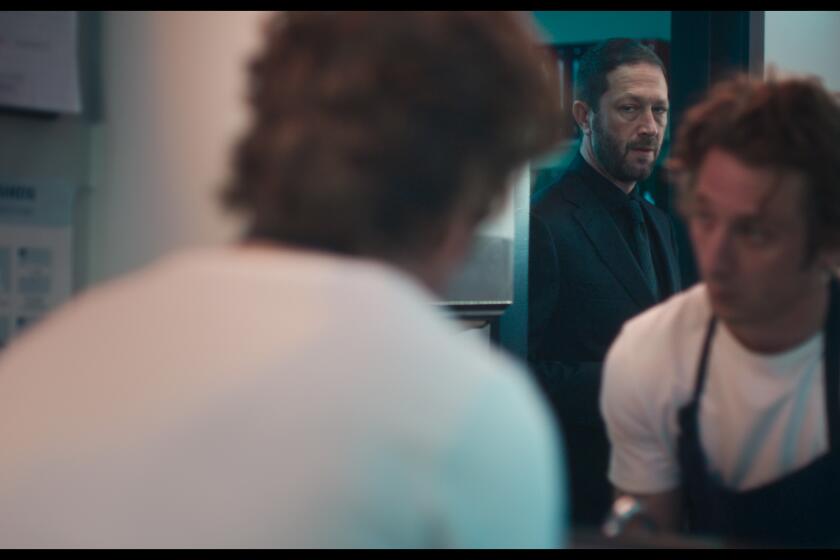BUILDING ON THE PAST : A Handful of Architects Is Breathing New Life Into Old County Buildings
- Share via
Architect Robert Borders is more interested in breathing new life into the past than dwelling in it, although he does a little of that too.
While armies of his colleagues turn hillsides into housing tracts or transform the skyline with multistoried steel and glass structures, Borders is among a handful of architects in Orange County specializing in resuscitating buildings that time and fashion have overlooked. And his surroundings mirror his interests.
Parked on a row of shelves in his Newport Beach office are rows of antique model trains, some built of wood or metal and some, made at the turn of the century, with working steam engines.
On a nearby table is an old Philco radio--it still works--on which Borders as a boy listened to news about the bombing of Pearl Harbor.
His draftsman’s table is a huge wood-and-steel contraption with metal gears that fills at least a quarter of the spacious office. The table was originally designed to be hand-cranked, but Borders has incorporated an electric mechanism so the angle can be adjusted with the push of a button.
The pipe-smoking Borders, who has a warehouse full of old catalogues and magazines and a library of Life magazines, likes nothing better than poking around old bookstores while researching a project, or piecing together, usually sans aid of original drawings, a building’s former character.
In the process he often stumbles onto what some might consider junk, but which he considers little gems. While tearing into a Fullerton motel dating back to about 1940, Borders uncovered in one of the closets a huge oil painting originally commissioned in Canada for the Seagram whiskey company. Although unsure of the artist, Borders says the painting depicts frontier explorers in the wilderness. He finds the work delightful, just as he does an old Indian canoe and a dusty library collection from the early part of this century that he discovered on the second story of an old Midwest bank building he was renovating.
It’s readily apparent that this architect prefers old to modern, not only in his 25-employee Robert Borders & Associates office but also in his work, which includes refurbishing the 1930s-era Via Lido shopping district in Newport Beach and helping plan the Heritage Hill Historical Park in El Toro.
Granted, the county is relatively young and most of the projects Borders and his architectural counterparts work on were built in this century. “The great majority (of buildings) as yet have no historical significance,” Borders conceded.
Architect Rolly Pulaski, whose firm worked on restoration of the Old Orange County Courthouse in Santa Ana, admits that “you really have to scratch your head” to find something both old and worth saving in Orange County.
Based on a survey conducted by the Orange County chapter of the American Institute of Architects, roughly 8% of their 291 member firms now specialize in restoration architecture. Although relatively small, the number of firms that specialize in that category has increased by about 25% over the past 10 years, according to Kathy Davis, executive director of the county chapter.
By comparison, among architectural firms in San Francisco--a city with a deeper past that has elevated preservation almost to sacred status--24% specialize in restoration, based on 1985 figures. (The Los Angeles chapter could not provide a similar breakdown of its member firms.)
James Wilson, principal of the 12-member 30th Street Architects of Newport Beach, doesn’t need figures to confirm what he already knows: As new development proceeds at a gallop, a respect for the past follows at a slower but nonetheless influential pace.
“The neatest thing in Orange County is the difference in opinion over the last eight or nine years on preservation,” Wilson said. “A few years ago it was search and destroy. Now it’s ‘let’s give a good look before we destroy.’ ”
Old, of course, is relative. Orange County may be celebrating its 100th anniversary, but in some parts of the country, people live, work or worship in buildings that predate the signing of the U.S. Constitution.
Wilson, whose 12-year-old firm has resurrected such projects as Old Town Irvine (the oldest building dates to 1895), Ruby’s Diner on the Balboa Pier and the McFadden building in Newport Beach, chuckles when he thinks of the government official based in San Francisco who reviews projects for official historical status. The man works in a city chockablock with 19th- and early 20th-Century architecture and is not easily impressed when Wilson shows him a simple Victorian-era house in Orange.
The bemused expressions increase as Wilson travels farther east through the historic-status approval process. “When we talk . . . with people in Washington, they don’t understand that something 50 years old is important to us,” Wilson said.
Wilson, whose firm also specializes in assessing buildings for historic significance, said that to be eligible for National Register of Historic Places status--and to qualify for the attractive 20% federal tax credit that goes with it--a structure must have one or a combination of the following qualities: It has to be at least 50 years old, have architectural significance or style, be designed by a significant architect, or have been the site of an important historical event.
When architect Pulaski was tapped to turn the old San Juan Capistrano railroad depot and baggage room into a restaurant and bar in the early 1970s, the building had been abandoned for 15 years. Even the train didn’t stop there anymore. The 1896-vintage masonry building--”Most all old buildings (in Orange County) of any quality are masonry”--had to be reinforced for earthquake safety, and the building’s archways had to be glassed in. When the surface was sandblasted, the architect discovered what he considered a beautiful combination of brick and stone underneath. Unfortunately, some of the locals preferred the original muddy plaster facade. Pulaski petitioned city officials and eventually won permission to keep the brick exposed.
Pulaski, who is principal member of the 17-person Pulaski & Arita Architects of Newport Beach, grew up on Balboa Island. He remembers playing touch football as a boy in uncrowded streets, using the curbs as boundary lines. If a car parked against the curb, Pulaski and his teammates would simply move to the next uncrowded street.
His fondness for the area sparked him to invest in one project--and in the process add an extra layer of folklore to a local landmark.
During its heyday, the Balboa Inn was supposedly the meeting place of prominent Los Angelenos. Built in 1928, it was only a block away from the Rendezvous Ballroom where the big bands played. But by 1975, “it was a real sleaze-bag place.” Pulaski said.
Twice daily, on his way to and from work, Pulaski would drive past the Spanish colonial-style building.
“I sort of fell in love with it, which is always a mistake,” Pulaski said.
He persuaded an accountant friend to invest and together they renovated the old beauty into 10,000 square feet of retail and commercial space and 34 hotel rooms. To market their new venture, Pulaski decided to capitalize on the building’s glamour and conjured up a few famous names--”Errol Flynn slept here”--for the brochures. Myth, as it sometimes does, evolved over time into “truth.”
“No doubt some of them stayed there at one time, but I don’t know for sure,” Pulaksi said.
Pulaski and his partners owned and operated the venture profitably for four years before selling it to a group of investors.
Historical accuracy also gets a wink and a nod at the “historic” Cannery Restaurant in Newport Beach. The turn-of-the-century building was for decades a landmark in Newport Harbor. But the cannery eventually outlived its usefulness as the area turned away from commercial fishing and toward pleasure boating. The building had stood vacant for a year by the time it was torn down in the mid-1970s and Pulaski was commissioned to work on a new building.
Copying some of the former building’s features, such as the pitched roof and metal siding, Pulaski built a restaurant--about half the size of the original structure--on the site. The new owners enhanced the historic feel with interior decor, using old photographs from the area. The site upon which the new restaurant sits may be old, Pulaski said, but the building, which is often mistaken for historic by the public, is definitely modern.
Sometimes restoration involves expanding and capitalizing on an existing structure. The Sherman Library and Gardens Coast Highway in Corona del Mar now encompass an entire city block, but they had their start in a small one-room adobe home built in 1940. Over the years, the home was turned into an office, then expanded upon. The land was eventually bought by descendants of educator Moses H. Sherman and donated to the community for use as botanical gardens and a research library specializing in the Pacific Southwest.
Twenty years ago, Borders was hired to upgrade the area adjacent to the house into an arbor and patio. Working from scratch, he designed a coffee garden set around a fountain and arbor that led to a sprawling pepper tree planted the same year the house was built. Careful to retain the Southwest feel of the original adobe structure, Borders used craftsmen to carve the wooden arbor beams and hammer out the metal brackets that hold them together. The concrete trim designed for the fountain and repeated in the steps was custom-cast.
In 1976, Borders designed a plan to refurbish the Via Lido shopping district next to Lido Isle in Newport Beach. A man-made island developed in the 1930s, Lido Isle was primarily a getaway spot for boating enthusiasts. The shopping district, which included the former Richards Market--now Hughes Lido Market--catered to the wealthy vacationers; the market specialized in delivering custom orders to the boats.
The old shops were given face lifts and copper roofing was added. The character of the market--which has always served as the anchor of the shopping district--was carefully retained. The Balboa theater, however, was left untouched--it already had what Borders described as “architectural integrity.”
For all the buildings saved, many are subject to the wrecking ball. Pulaski talks wistfully about the now extinct sugar-beet factory, a beautiful old brick building in Santa Ana that was torn down about five years ago. e
Although preservation has increased in Orange County over the past decade--restoration of downtown Santa Ana represents the largest commercial rehabilitation project in the state--this area pales in comparison to others, said Robert Sellway, chief of cultural and historical programs for Orange County.
“People in Orange County are not as interested in preservation in general as people in communities that have embraced preservation for a number of years,” Sellway said.
And the steamroller of new development is formidable.
“You’ve got to plan ahead” for future generations, Borders said. “We do not save enough of it.”
More to Read
The biggest entertainment stories
Get our big stories about Hollywood, film, television, music, arts, culture and more right in your inbox as soon as they publish.
You may occasionally receive promotional content from the Los Angeles Times.










